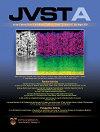Effects of duty cycle and nitrogen flow rate on the mechanical properties of (V,Mo)N coatings deposited by high-power pulsed magnetron sputtering
IF 2.1
3区 材料科学
Q3 MATERIALS SCIENCE, COATINGS & FILMS
引用次数: 0
Abstract
(V,Mo)N is theoretically predicted to have high hardness and fracture toughness and is a promising material for the application on protective hard coatings. However, the toughness enhancement of (V,Mo)N coatings deposited by dc-unbalanced magnetron sputtering (dc-UBMS) was not as remarkable as expected. The issue could be due to insufficient energy delivery to the plasma species in the deposition process such that nitrogen and metal atoms were not fully reacted and led to the degradation of coating quality. Since high-power pulsed magnetron sputtering (HPPMS) can provide high peak power density, the method was selected to deposit (V,Mo)N coatings in this research. The objective of this study was to investigate the effects of duty cycle and nitrogen flow rate on the microstructure and mechanical properties of (V,Mo)N coatings deposited on Si substrates by HPPMS. Four sets of (V,Mo)N coatings were deposited by HPPMS at different durations with two duty cycles, 5% and 3%, and two nitrogen flow rates, 6.0 and 12.0 SCCM. The results showed that the N/metal ratio was mainly affected by the nitrogen flow rate, ranging from 0.70 to 0.96 with increasing nitrogen flow rate. The lattice parameter of the samples linearly increased with the N/metal ratio. The x-ray diffraction (XRD) patterns revealed that all samples tended to approach (200)-preferred orientation with increasing deposition duration. The glancing incident XRD patterns indicated that the samples deposited at 6 SCCM nitrogen flow rate and 3% duty cycle have multiphases. Transmission electron microscopy analysis confirmed that phase separation from (V,Mo)N to (V-rich,Mo)N and (V,Mo-rich)N occurred in those samples. The hardness of the (V,Mo)N coatings decreased with increasing N/metal ratio, which may be related to the N-vacancy hardening effect. The sample deposited at 6 SCCM nitrogen flow rate and 3% duty cycle for 36 h showed the highest hardness of 28.4 GPa, which was possibly associated with the phase separation, and hence plastic deformation became difficult. The fracture toughness (Gc) of the (V,Mo)N coatings was evaluated using the internal energy-induced cracking method. The resultant Gc of the (V,Mo)N coatings, ranging from 36.1 to 43.7 J/m2, was higher than that of the coatings deposited by dc-UBMS in our previous study. The toughness enhancement could be caused by a higher fraction of Mo–N bonding due to the adequate reaction energy provided by the HPPMS process.占空比和氮流量对大功率脉冲磁控溅射(V,Mo)N涂层力学性能的影响
理论上预测(V,Mo)N具有较高的硬度和断裂韧性,是一种很有前途的防护硬膜材料。然而,直流不平衡磁控溅射(dc-UBMS)沉积的(V,Mo)N涂层的韧性增强并不像预期的那样显著。该问题可能是由于沉积过程中向等离子体输送的能量不足,导致氮原子和金属原子没有完全反应,导致涂层质量下降。由于大功率脉冲磁控溅射(HPPMS)可以提供较高的峰值功率密度,因此本研究选择该方法沉积(V,Mo)N涂层。本研究的目的是研究占空比和氮流量对HPPMS沉积在Si衬底上的(V,Mo)N涂层的微观结构和力学性能的影响。采用HPPMS在5%和3%占空比、6.0和12.0 SCCM两种氮气流量下,在不同时间下沉积4组(V,Mo)N涂层。结果表明:氮/金属比主要受氮流量的影响,随着氮流量的增大,氮/金属比的变化范围在0.70 ~ 0.96之间;样品的晶格参数随N/金属比线性增加。x射线衍射(XRD)图谱显示,随着沉积时间的延长,所有样品都趋向于(200)优先取向。掠射XRD图谱表明,在氮气流量为6 SCCM、占空比为3%时沉积的样品具有多相结构。透射电镜分析证实,这些样品发生了从(V,Mo)N到(V,Mo)N和(V,Mo-rich)N的相分离。(V,Mo)N涂层的硬度随N/金属比的增加而降低,这可能与N空位硬化效应有关。当氮气流量为6 SCCM,占空比为3%时,沉积36 h,样品的硬度最高,为28.4 GPa,这可能与相分离有关,因此塑性变形变得困难。采用内能致裂法对(V,Mo)N涂层的断裂韧性(Gc)进行了评价。所得(V,Mo)N涂层的Gc值在36.1 ~ 43.7 J/m2之间,高于我们之前研究的dc-UBMS涂层。由于HPPMS过程提供了足够的反应能量,因此较高比例的Mo-N键可以引起韧性增强。
本文章由计算机程序翻译,如有差异,请以英文原文为准。
求助全文
约1分钟内获得全文
求助全文
来源期刊

Journal of Vacuum Science & Technology A
工程技术-材料科学:膜
CiteScore
5.10
自引率
10.30%
发文量
247
审稿时长
2.1 months
期刊介绍:
Journal of Vacuum Science & Technology A publishes reports of original research, letters, and review articles that focus on fundamental scientific understanding of interfaces, surfaces, plasmas and thin films and on using this understanding to advance the state-of-the-art in various technological applications.
 求助内容:
求助内容: 应助结果提醒方式:
应助结果提醒方式:


